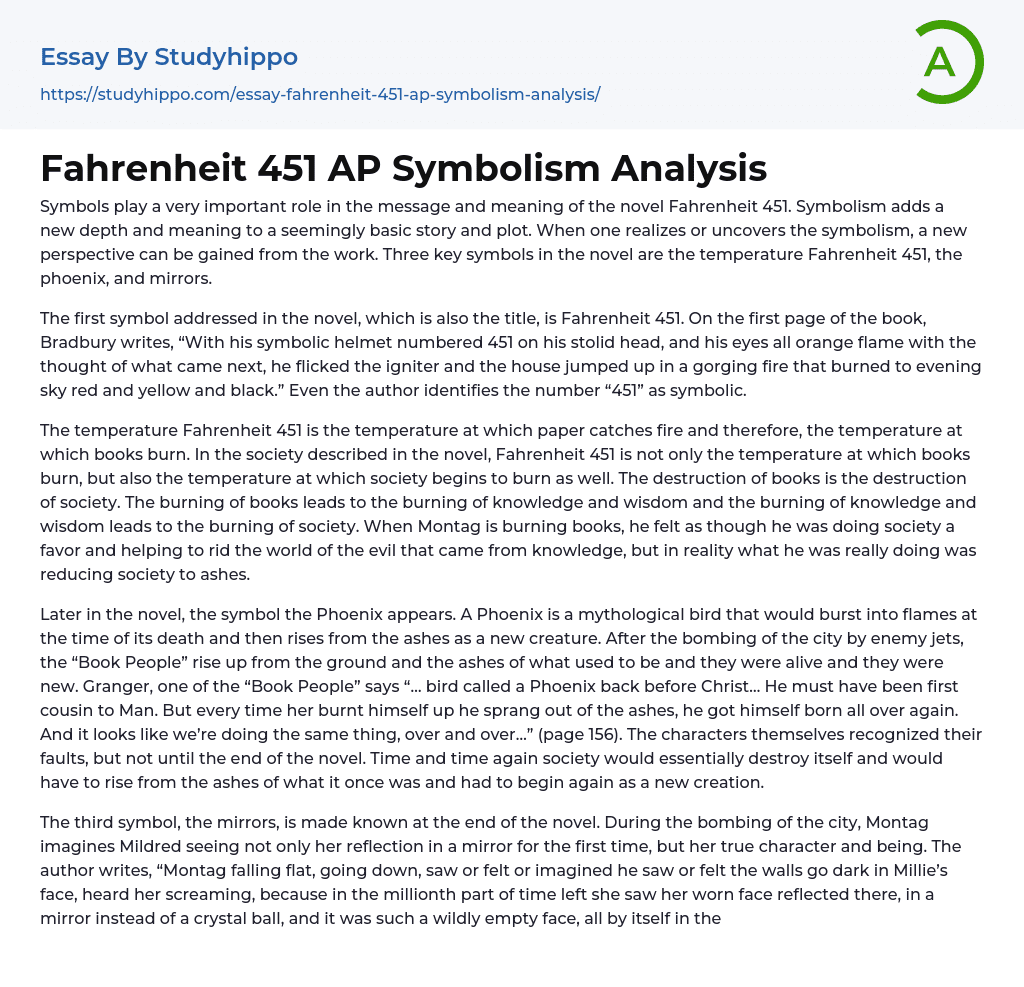Symbols hold significant significance in the novel Fahrenheit 451, contributing depth and meaning to its seemingly straightforward story and plot. By uncovering the symbolism present, one can gain a fresh perspective on the work. Among the notable symbols within the novel are the temperature Fahrenheit 451, the phoenix, and mirrors.
The first symbol addressed in the novel, also the title, is Fahrenheit 451. In the beginning of the book, Bradbury describes a protagonist with a helmet marked as 451 on his head and eyes glowing orange with anticipation. He lights a fire that engulfs a house in a display of red, yellow, and black. The author himself acknowledges the significance of the number "451" as symbolic.
The temperature at which paper catches fire is known as Fahrenheit 451. This
...temperature also represents the point at which books burn. In the society depicted in the novel, Fahrenheit 451 not only symbolizes the burning of books, but also signifies the beginning of societal destruction. The act of destroying books is equivalent to destroying society itself. Burning books results in the loss of knowledge and wisdom, which ultimately leads to the disintegration of society. When Montag engages in burning books, he naively believes that he is helping society by eradicating the dangers associated with knowledge. However, in reality, his actions are merely reducing society to ashes.
Later in the novel, the symbol of the Phoenix is introduced. The Phoenix is a legendary bird that would set itself on fire upon death and then emerge as a new creature from the ashes. Following the bombing of the city by enemy jets, the "Book People
rise from the ground and the remains of what was once there, reborn and full of life. Granger, one of the "Book People," describes the Phoenix as a bird that existed even before the time of Christ. He compares it to mankind, explaining that every time the Phoenix burned itself, it emerged from the ashes and began life anew. Granger reflects on how they, too, are repeating this cycle of destruction and rebirth. It is only towards the end of the novel that the characters themselves acknowledge their faults. Society continuously falls apart and must rebuild from its former state as a fresh creation.
The third symbol, the mirrors, is revealed at the end of the novel. During the city's bombing, Montag envisions Mildred finally seeing not just her reflection in a mirror, but her true essence and identity. The author states, "Montag falling flat, going down, saw or felt or imagined he saw or felt the walls go dark in Millie’s face, heard her screaming, because in the millionth part of time left she saw her worn face reflected there, in a mirror instead of a crystal ball, and it was such a wildly empty face, all by itself in the room, touching nothing, staved and eating of itself, that at last she recognized it as her own..." As the "Book People" embark on their journey to what remains of the city, they discuss their plans for aiding the survivors. Granger suggests, "Come on now, we’re going to go build a mirror factory first and put out nothing but mirrors for the next year and take a long look in them.” (page 157). Granger proposes
using mirrors to reveal people's true nature instead of the superficial facade dictated by society.
In the novel Fahrenheit 451, several symbols such as the temperature Fahrenheit 451, the phoenix, and mirrors are present. These symbols contribute to the depth of the work and offer a fresh perspective on the novel, the world, and even oneself. While the story and plot may seem simple at first glance, further examination reveals a wealth of knowledge and wisdom waiting to be discovered, comprehended, and utilized.
- Book Summary essays
- Metaphor essays
- Reader essays
- Rhyme essays
- Literary devices essays
- Villain essays
- Books essays
- Genre essays
- Literary Criticism essays
- Writer essays
- Protagonist essays
- Simile essays
- Poem essays
- Book Report essays
- Book Review essays
- Greek Mythology essays
- Plot essays
- Tragic Hero essays
- Coming of Age essays
- Play essays
- Rhetoric essays
- Rhetorical Question essays
- Translation essays
- Understanding essays
- Reason essays
- Character essays
- Letter essays
- American Literature essays
- Literature Review essays
- Utopia essays
- Poetry Analysis essays
- Dante's Inferno essays
- Between The World and Me essays
- Incidents in The Life of a Slave Girl essays
- Flowers for Algernon essays
- Myth essays
- Everyday Use essays
- Boo Radley essays
- Genesis essays
- Richard iii essays
- Alice in Wonderland essays
- On the road essays
- Ozymandias essays
- The Nightingale essays
- Holden Caulfield essays
- Animal Farm essays
- 1984 essays
- A Hanging essays
- Shooting An Elephant essays
- A Tale Of Two Cities essays




